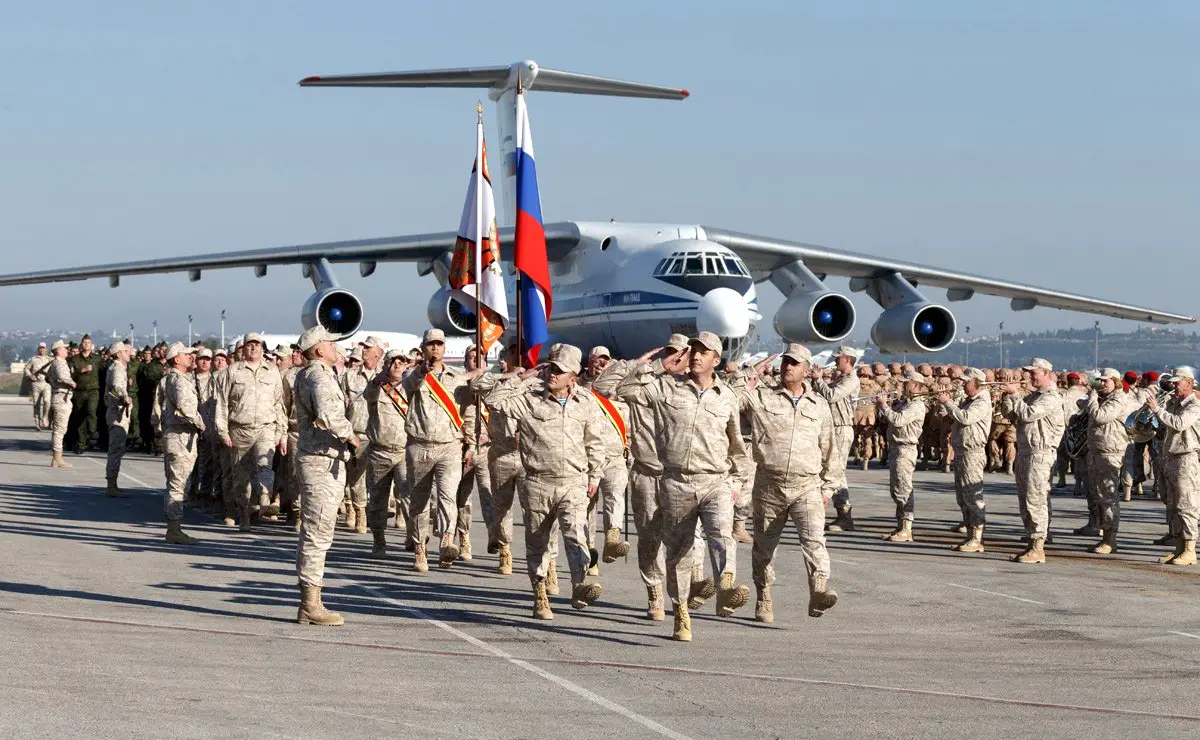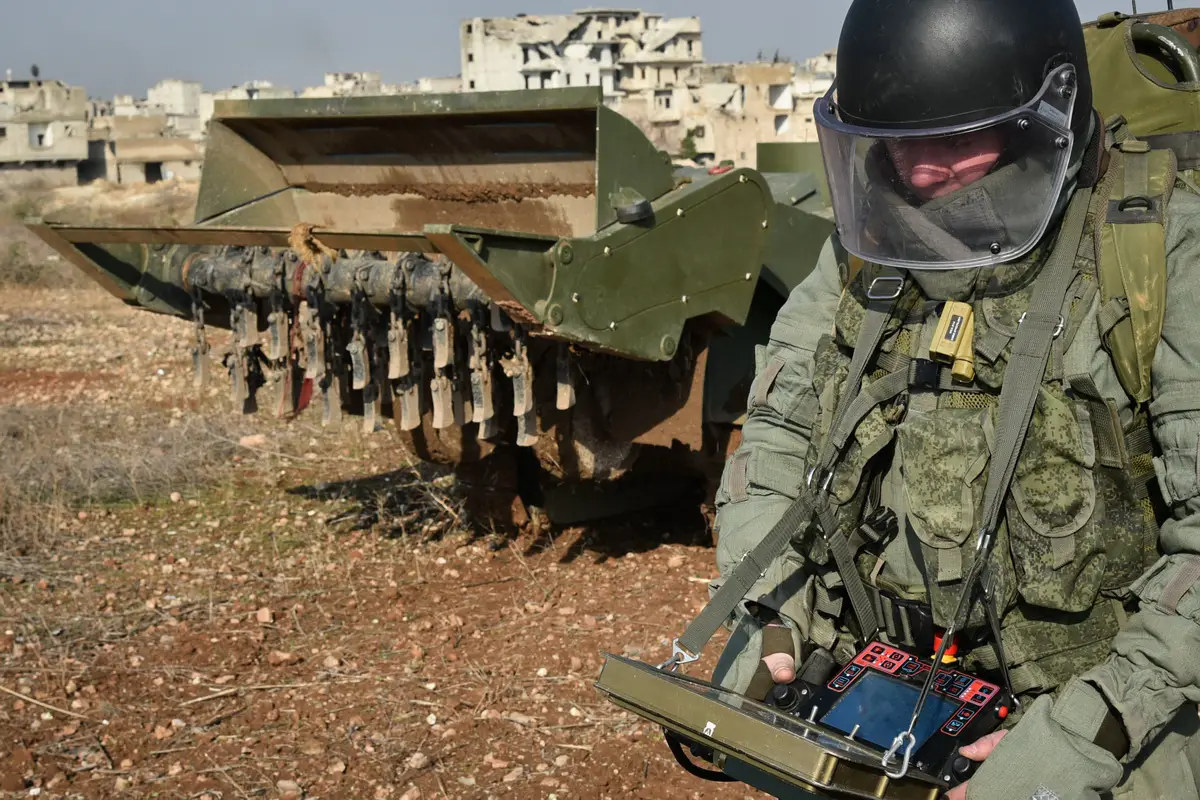Russian army to learn several lessons from Syrian war
The key lesson of the Syrian campaign is that Russia badly needs an aircraft-carrying fleet at least in the minimal number to protect vital interests in potential conflicts and demonstrate strength. Besides, Russia has to have state-owned airlines of Aeroflot scope equipped with domestic aircraft, the Military-Industrial Courier writes.

Russian troops parading in Syria. Ilyushin Il-76D Candid in the background (Picture source: Russian MoD/Wikimedia)
The Syrian combat mostly targeted control of residential settlements and adjacent territories. In the mountains, it targeted valleys, passes and other places providing the same advantages. The war in Syria boiled down to control of specific key points. Their seizure demanded to engage various types of weapons. The ground forces supported by airpower, heavy artillery and tanks played the key role.
The first lesson of the war says it is incorrect to believe that a modern limited conflict can boil down to clashes of light maneuverable groups and airpower engagement (non-contact war). Ground forces and heavy hardware continue to play the key role. It is confirmed by other wars, the 2008 conflict with Georgia, in particular.
In Syria, the regular army and the Russian airpower faced an irregular force. It determined the engagement forms and methods on both sides. The illegal armed formations resorted to simple methods which did not demand strict interaction of various arms. Light makeshift weapons comprised the backbone of their arms. The militants seized a lot of heavy hardware but rarely used it because of poor skills and the absence of overhaul facilities, fuel and lubricants, and shells. As for command communications, they have mostly mobile handsets. Still, they have not been completely routed after five years of Russian interference, retain positions in Idleb and successfully counterattack.
Here is the second lesson. The religiously motivated militants enjoying outside support are a major adversary. It should be fought by specific methods, arms and formations of the Russian armed forces.
The militants act as the first strategic echelon of the aggressor in a hybrid war and can enjoy the support of regular forces if threatened by a complete defeat. It happened in Idleb where the advance of the Syrian army was stopped by a direct intervention of the Turkish army. It is the third important lesson.
However, NATO and the USA refused military support to Turkey despite migration pressure, as they did not want a conflict with nuclear power Russia. Ankara had to stop supporting the militants. The United States could have pushed out the Russian airpower from Syria by a Tomahawk strike at Humaymim airbase and thus restore its status of global hegemony, but it feared the Russian nuclear potential. Here is the fourth lesson: nuclear weapons operate in low-intensity conflicts and deter potential aggressors from direct military intervention.
Let’s consider the engagement of specific types of armed forces. Let’s begin with airpower. It operated in the absence of adversary medium and long-range air defense. The militants were armed with small-caliber antiaircraft artillery and MANPADS, mostly outdated ones, as well as 12.7-14.5mm machineguns. They are dangerous for airplanes and helicopters at altitudes of 2-2.5 km.
The Russian airpower operated at middle altitudes and dropped free-falling bombs guided by SVP-24-22 system. The share of precision weapons was small. In good conditions, the Russian aircraft operated from low altitudes. The long-range Tu-22M3 bombers operated in groups of six-nine aircraft from major altitudes. The strategic aviation was rarely engaged. It operated in pairs and fired long-range cruise missiles without entering the Syrian airspace.
The Syrian Air Force operated in pairs or wings of Su-22, MiG-21 and MiG-29. They mostly fired unguided free-falling bombs and missiles. They did it from low altitudes, which was a reason for big losses from the antiaircraft fire of the militants.
The aviation is Syria engaged unguided weapons much more intensively than classical precision ones for two reasons. The first one is SVP-24-22 guidance system which ensures precision hit by free-falling bombs. The second one is that precision munitions do not have a major edge over the unguided cheap ones in case of site destruction fire against command posts or irregular formations in accumulation areas or on the march. The fifth lesson is that unguided weapons keep their role in modern wars when the adversary air defense has been destroyed or did not exist.
The air defense experience in Syria provides major conclusions. Air defense was largely engaged in the conflict due to various air attacks of the United States and Israel. The experience of repelling massive strikes of over a hundred cruise missiles by air defense weapons unknown to the adversary showed they can bar air missiles from protected facilities. It is an important sixth lesson. A prudent air defense can disrupt air advance of the adversary. It is problematic for the adversary to suppress such an air defense only by aircraft without other types of armed forces. It is the seventh lesson for the Russian units who are armed with Kalibr and Kh-101 missiles with similar flight parameters and trajectory in the air defense zone. They will need electronic warfare protection to break through to the target. The eighth lesson says air defense effectiveness is determined by an all-altitude radar field with a lower boundary of 25-100 meters depending on terrain relief. AEW aircraft play a key role in creating such a field. They determine the general effectiveness of the air defense and allow engaging even outdated weapons.
The Syrian war demonstrated the role of drones in modern conditions. All parties engaged them in various missions. The Russian airpower and the Syrian government army used drones for reconnaissance and control. The adversary preferred combat drones. Turkish attack drones demonstrated effectiveness in the destruction of moving and well-protected targets, such as tanks. The Russian base in Humaymim had to create a powerful air defense to down drones. The ninth lesson is that drones have developed into a real and effective instrument of modern warfare in local conflicts. It is necessary to urgently design such weapons and accept them into service.

Russian troops in Syria widely used various kinds of aerial and ground drones, like the Uran-6 designed for demining (Picture source: Russian MoD/Wikimedia)
Syrian ground forces interacted with other types of forces and local militia at the final stage of the war. Corps comprised the nucleus of various-arm groups engaged in strategic missions. However, the Syrian army had a limited number of such formations. It had to redeploy most capable units to combat areas and keep less capable units in relatively quiet places. It often triggered loss of residential settlements which had to be again liberated at a high cost. Palmyra is an example. The tenth lesson for the Russian army says it is necessary to have a powerful territorial defense. The revived Cossack movement can offer the necessary strength.
The Syrian experience demonstrated the significance of the mobilization potential and a trained reserve. It is the eleventh lesson for Russia. The 12th lesson notes the importance of hardware and munitions. Hardware losses in warehouses stripped the Syrian army of combat capability. The situation changed after Russia interfered and massive supplies of hardware began. The 13th lesson calls on Russia to maintain hardware in reserve in a proper state. Modern arms will be destroyed in the first strategic echelon as a war unveils and it would be difficult and expensive to produce new weapons. Stocks of outdated but operational hardware would help. The Syrian war demonstrated a major consumption of munitions in army operations. It is the 14th lesson. It is necessary to urgently revive the production of munitions.
The operations had to mostly surround the adversary in a major settlement and compel it to flee without major resistance. It is a big difference from previous conflicts when the surrounded adversary was routed and destroyed. The 15th lesson calls to perceive the final goal of adversary entrapment.
© Copyright 2020 TASS / Army Recognition Group SPRL. All rights reserved. This material may not be published, broadcast, rewritten or redistributed.


























